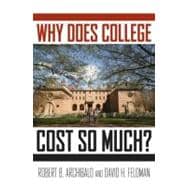
Note: Supplemental materials are not guaranteed with Rental or Used book purchases.
Purchase Benefits
What is included with this book?
| Introduction | |
| The Landscape of the College Cost Debate | p. 5 |
| Is Higher Education All That Unusual? | p. 19 |
| Costs | |
| Higher Education Is a Service | p. 35 |
| The Costs of Employing Highly Educated Workers | p. 49 |
| Cost and Quality in Higher Education | p. 63 |
| The Bottom Line: Why Does College Cost So Much? | p. 82 |
| Is Higher Education Increasingly Dysfunctional? | p. 92 |
| Productivity Growth in Higher Education | p. 114 |
| Tuition and Fees | |
| Subsidies and Tuition Setting | p. 137 |
| List-Price Tuition and Institutional Grants | p. 150 |
| Outside Financial Aid | p. 171 |
| The College Affordability Crisis | p. 185 |
| Policy | |
| Federal Policy and College Tuition | p. 201 |
| Financial Aid Policy | p. 214 |
| Rewriting the Relationship between States and Their Public Universities | p. 235 |
| A Few Final Observations | p. 252 |
| Data on Costs and Prices | p. 263 |
| Granger Causality Tests of the Bennett Hypothesis | p. 267 |
| Notes | p. 271 |
| Bibliography | p. 277 |
| Index | p. 283 |
| Table of Contents provided by Ingram. All Rights Reserved. |
The New copy of this book will include any supplemental materials advertised. Please check the title of the book to determine if it should include any access cards, study guides, lab manuals, CDs, etc.
The Used, Rental and eBook copies of this book are not guaranteed to include any supplemental materials. Typically, only the book itself is included. This is true even if the title states it includes any access cards, study guides, lab manuals, CDs, etc.